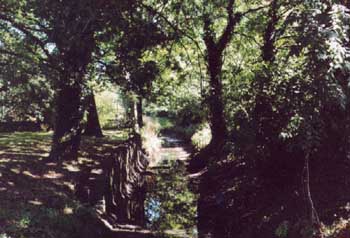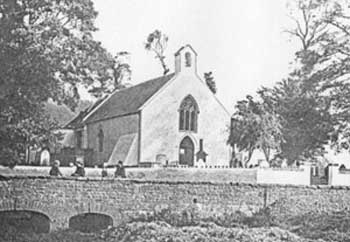Coming past Waterloo Gardens in summer mid-evening you can
see the attraction. Tight grass, wide beds, paths than snake, unsullied
benches. NO CYCLING by all four entrances. This fails to stop kids on
fat-tyred two-wheelers from steaming through, breaking the thin lower
branches on the park's new cherry trees and frightening the dogs. But
it doesn't happen much. This is the park where the silver band plays
on Sundays and you take your babies to teach them to walk. There's a
brook running through here, looped down from Llanishen Reservoir to
the north. It divides into two channels - the old course and, a few
yards from that, a dug channel. Joining up the old rivers. Protection
against flooding. That happened. There was a tidemark a few feet up
the wall of the Dairy. That's a hairdressers now. At the Post Office
the stamps almost floated out through the door. NO BATHING warns a sign.
And nearby more NO CYCLING. We write things down a lot in the UK. Near
here was once the green hut that contained the youthfully carved name
of the poet Dannie Abse. He told me where to look but when I visited
the hut had been pulled down.
The brook - Nant Fawr, Nant y Lleici - was utterly unpronounceable
for the entire length of my childhood. But demographies change. At
the back of the Minsters someone's named their house after it. And
there's another half-way up Westville. Unwaith eto mae'r cymru wedi
dod.

The Lleici looking south
At night you can stand on the road that separates the Gardens from
its larger neighbour, the Mill Park, and hear the piped waters of
the stream. Local legend has it that a tributary once sluiced down
Penylan Hill before erupting into the Lleici below in a torrent of
meadow flooding foam. But there's little evidence on the old maps.
The waters rush deep, now, dark, their magic compromised, contained.
The Mill was real but all that's left is a bunch of worked stones
let into the brook embankment. The wheel and its house are long gone.
The grind stone smashed. The park here - another in the five mile
stretch that arcs from Llanishen to the Harlequin Fields - once grew
wheat, barley, oats and beans. Now you come if you want to wreck bushes,
throw frisbees or do yourself on drugs. You can hear the young crashing
through the weekend dark nights when it doesn't rain. Squirrels, condoms,
Castlemain.
As we go north, along the thin Westville Park, dug-up, re-grassed
and pathed; shaped like the State of Delaware; the ground rises imperceptibly.
Willows weep into the stream by the houses - all different from each
other, all with flood marks beneath their hall wallpaper. South of
Sandringham Road, running parallel to Westville, was once a brickworks.
The clay pits are now sunken gardens. The houses oblivious, industry
moved on.
Beyond are the Recreation Grounds. First the bridge, the library,
the new community centre, park offices, the bark-surfaced kids play
area with artificial hill and climbing frame like a Frank Lloyd Wright
construct. Then the fields - tougher grass - soccer, baseball, running,
whooping, dog chasing, things with bats. Rough kids after the war.
A downed Messerschmidt. Bust bikes. Bent my arm here once. Now it's
cool Asians and Afro-caribbeans who always score. Top end are the
karate mystics, body rings, tattoos, jugglers, and guys with shaved-heads
and dogs. Someone with a tai chi sword is slowly slicing through the
form, the energy all inside, moving like a man underwater. A pensioner
from the rich Ty Draw houses opposite reports him for unsheathing
a weapon in a public place. It's my religion, the practitioner claims.
The investigating officer replaces his notebook with the same liquid
movement the swordsman used. "Next time," he says with a
half-smile, "try singing hymns."

The first St Margaret's Church in 1867. That's
one of the tributaries of the Lleici to the left of the Church. Gone
now. Drained. Taken away in pipes.
Peter Finch
back to the top